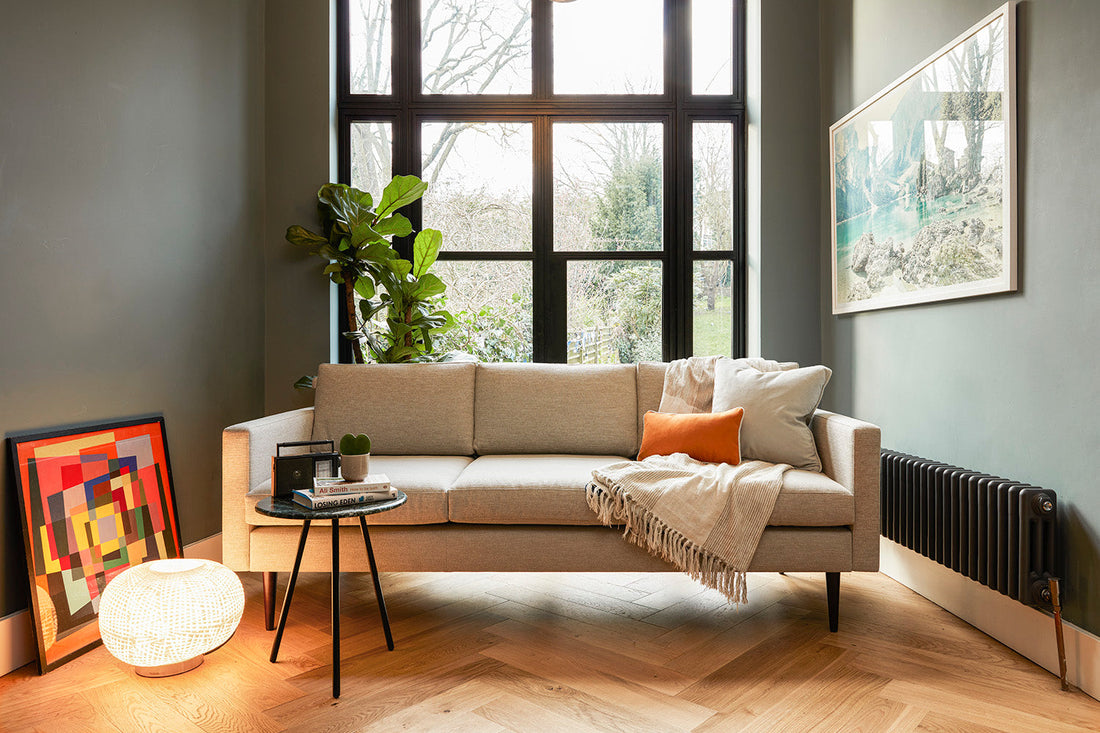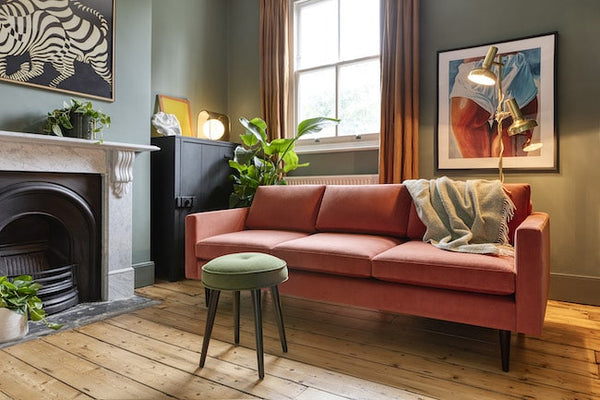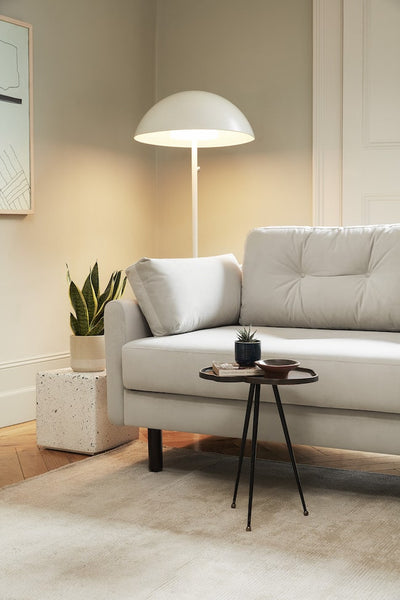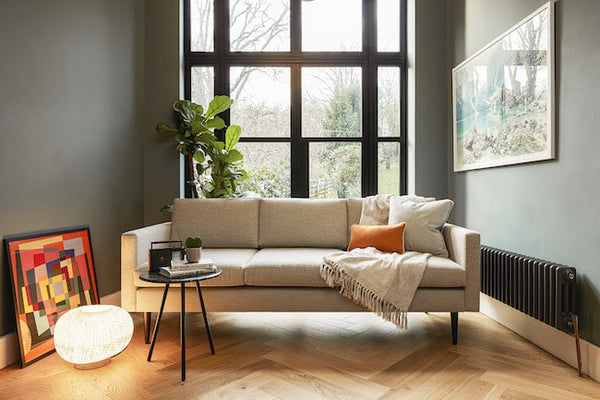17 small living room decor ideas that will help you make the most of your space

17 small living room decor ideas that will help you make the most of your space
Having a small living room does not mean that you have to kiss goodbye to creating a stylish and comfortable space.
In fact, there are no end of ways you can transform that small lounge into a stylish, sophisticated and perfectly-proportioned living area.
And we are about to show you how.
Let’s take you through the 17 tips and tricks that can help you overcome the challenges your small living room presents.
Here you’ll discover how to get creative with your furniture selection, clever with your paints and cunning with your curtains, as you learn the secrets of making your small room feel much bigger than it actually is.
You’ll be surprised to discover that, with just a little creativity and know-how, you can create a well-designed living room that, deceptively, looks bigger.
Whether you are designing for family life or for entertaining friends, you’ll be able to quickly pick up all the décor ideas you need to transform your compact space into a comfortable, cosy room.
Furniture tips for small living rooms

Here we look at ways you can get inventive with the placement of your three-seater sofa and the rest of the furniture that you choose for your room.
1. Choose seating and sofas with legs
Seating that has legs allows more of the floor to be seen. It creates less of a bulky appearance and so helps to give a visual impression of a larger room.
Fortunately, there are many classic sofa and armchair styles that have been finished with beautifully turned wooden legs, so you don’t need to trade in a sense of style for the illusion of space.
2. Trade in your sofa for a ‘snuggler’
Large sofas will very quickly dominate your room and leave you with little space for anything else on the floor. It may be possible for you to consider opting for a less invasive, 1.5-seat ‘snuggler’. These are also referred to as ‘loveseats’ and are most certainly ideal for either a parent and child or for a loved-up couple.
3. Swap stools for chairs
You need to avoid at all costs over-filling your small space with furniture. However, this doesn’t always have to mean having less furniture. Instead, you should choose the furniture in your room judiciously.
One example of this is opting for a sofa that’s in proportion to the size of your available space. You may decide to go for a two-seater sofa rather than a three-seater. Should this leave you needing more seating, you can use stools (or even bean bags). Stools take up far less room than the bulk of an armchair, and are much easier to move around when required.
Another way to choose your furniture judiciously to save space would be to consider swapping an upholstered armchair for a slim wooden rocker with cushions.
It’s always worthwhile to keep your eye out for furniture that has been designed to stow away. You’ll often find handy space savers such as a cubed stool that can slip under a coffee table when it is not being used.
4. Get multi-functional with your furniture
Don’t be afraid of investing in multi-functional furniture. It doesn’t have to be cheap and gimmicky but can be a real bonus when space is at a premium.
Look out for, among many other options, coffee tables that double as a storage bin, lidded stools for storage, sofas with sofa beds and sofas for office spaces.
5. L-shaped sofas are not just for large rooms
In terms of seating per square foot of floor space, L-shaped sofas win hands down over traditional sofas. They can often sit five or six where other sofas would struggle to sit four.
If you have a tight eaves space, placing an L-shaped sofa can be the perfect solution. Pair it with trunks that can function as coffee tables, handy storage or even extra seats, and you have a very compact but cosy seating area.
Storage tips for small living rooms

Here we look at how storage can help you clear clutter from your room and how you can best incorporate your storage options without closing in your space.
6. Fill your alcoves
Any alcoves or bay windows in your room can be fitted-out with built-in storage. These existing indents are the perfect way to incorporate shelves and cupboards that do not jut out into the room itself.
7. Store vertically
The secret of maximising the space in your small living room is to utilise every inch that is available to you.
When you are thinking through your possible storage solutions, do not be shy of making the most out of the free vertical space on walls.
If you stagger your shelves, you can use both sides of adjoining walls. This will also help to open out the visual impact of the shelves, as they are no longer in one uniform line.
Floating shelves are perfect for small rooms. They can hold a lot of things but their minimalist, unobtrusive design keeps unnecessary support to a minimum.
8. Hang baskets to hide clutter
Every piece of floor matters when you are trying to create space. This means that you are going to need somewhere for all of those small bits and bobs that quickly start to clutter up a room.
You can use attractive baskets hung from decorative hooks on the wall to act as a place where you tidy up things like toys, books, magazines, iPads and anything else that is left lying around at the end of each day.
9. Mount the TV
Wall-mounted TVs are definitely the best option for smaller rooms as they do not take up any of your valuable floor space.
Decorating tips for small living rooms

Here we look at how you can use decorative effects on your walls to help open out your small living area.
10. Use neutral, light shades
When you decorate your small, snug area you can give the impression of space by choosing soft, neutral shades. These help to keep the room warm and inviting, without closing it in as darker colours will.
Blush pinks, pale blues and light greys or lilacs are all shades that will make any small living room feel fresh and inviting. Do steer clear of brilliant whites, however, as these can be rather intense on the eyes.
11. Paint the skirting boards
Forget conventional wisdom and enhance the sense of space in your room by painting the skirting boards in the same colour as your walls.
The effect of this is to make the wall itself appear significantly taller. Painting them white would merely emphasise where the wall comes to an end.
12. Add in a feature wall
One way to make your room feel warm, cosy and restful is to introduce a rich, darker colour on just one wall.
Rather than cramping your small space, using a deeper colour sparingly, instead provides a focal point that draws us in without making the room feel smaller.
Think carefully about where your feature wall will be – often placing it behind the sofa of a small room can give the best effect.
Tips for using light in a small living room

Light can be used to create focal points and to give the illusion of depth and space. Here’s how you can achieve the best effects.
13. Create space with mirrors
This is a trick most people should already know, but it’s so effective it’s worth reminding us all here.
Mirrors can instantly create the illusion of space, especially if you select an oversized mirror to cover an entire wall.
The mirror reflects both light and the décor itself back into the room – effectively doubling up the sense of space and making everything light and airy.
14. Replace your curtains with blinds
Blinds do not occupy the sides of your windows in the way that curtains do. This means they make the room feel that little bit longer.
Shutters are also a brilliant alternative to curtains. They offer plenty of privacy and allow you to control the incoming light without taking up space. Roman or roller blinds are another alternative.
If you do have curtains, make sure that you keep them light and can sweep them away from the window to let in as much light during the day as possible.
15. Use lighting to create focal points
Lighting is a simple but effective way to create an impression of a larger room.
Use it to light up dark corners and to create focal points in your room that can distract from areas of clutter elsewhere.
An overhanging pendant light, carefully positioned on a round coffee table, is a great way to mark out your living space. The two pieces create a focal point around which you can sit a couple of chairs and scatter some floor cushions or place some stools when guests arrive.
Architectural tips for small living rooms

Sometimes the architecture of the room creates challenges for us but, on other occasions, it can provide us with the perfect space-saving solution.
16. Make a virtue out of your awkward architecture
Many living rooms lack space because of their awkward room proportions. This is particularly true for period properties, where it’s often the features that we love – such as bay windows – that present a logistical challenge as we try and arrange our furniture.
It is possible, with a little creative thinking, to use these spaces to our advantage. For example, a compact sofa should fit neatly into these areas, without taking up valuable floor space elsewhere. Similarly, they can house bulkier furniture pieces, such as sideboards and TV units that are hard to fit in elsewhere.
17. Downplay the door
One common issue in smaller living rooms, especially in country cottages or studio flats, is having the front door open directly into your otherwise serene space.
You can downplay the intrusion of the door by creating a welcoming, focal point of neatly arranged seating in the room. For example, positioning a two-seater sofa at an angle to a cosy armchair, with a slim side table and lamp nearby, will create a space that looks truly inviting wherever you are in the room.
Make the most of your small living room space
Small certainly can be beautiful when we approach our décor creatively. And you now have 17 ways to make everything just so.
Looking for stylish sofas for a small living room? We’ve got you covered, check out our range of velvet sofas, boucle sofas or faux leather sofas.




